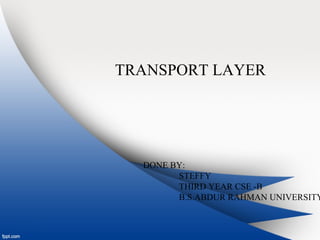
Flow control
- 1. TRANSPORT LAYER DONE BY: STEFFY THIRD YEAR CSE -B B.S.ABDUR RAHMAN UNIVERSITY
- 2. Contents
- 3. TCP Flow Control • Host has a receiver buffer on each side of TCP connection. • Data will be placed in the receive buffer only if the received data is correct. • Application process running on the receiver host will read data from this buffer.
- 4. Problem arises…… • Receiving application may be busy with some other work. • Data has to wait for a long time until it is read by application process which is running on host(receiver). • Sender can easily overflow the receiver buffer by sending too much of data quickly. • To overcome this problem ,TCP provides flow control service to its applications.
- 5. Continues…. • Flow control is a speed matching service the rate at which sender is sending , against the rate at the receiving application is reading. • TCP provides flow control by having the sender maintain a variable called the receive window. • The receiver window is used to give the sender a number of free buffer space is available at the receiver. • Since TCP is full duplex, sender at each side of the connection will maintains a receiver window.
- 6. File Transfer scenario Host A Host B TCP connection Large file Receiver Buffer
- 7. • Variables used in this scenario: 1.LastByteRead 2.LastByteRcvd • Receive window is represented by RcvWindow • RcvWindow=RcvBuffer-[LastByteRcvd-LastByteRead] • TCP is not allow the sender to overflow the allocated receiver buffer. • LastByteRcvd-LastByteRead <=RcvBuffer. • Spare room is changes with time, RcvWindow is dynamic.
- 8. How RcvWindow is used? • Host B tells Host A no of spare room available in its connection buffer. • By placing the current value of RcvWindow in the receive Window field of every segment it sends to A. • Initially , RcvWindow=RcvBuffer • Host A keep track of two variables: 1.LastByteSent 2.LastByteAcked • LastByteSent - LastByteAcked=No of Unacknowledged data
- 9. Continues…. • By keeping the unacknowledged data value less than the value of RcvWindow, Host A ensure that it does not overflow the RcvBuffer at Host B. • LastByteSent-LastByteAcked <= RcvWindow
- 10. TCP Connection Management Client Server Client- server scenario :In which process running in one host (client) wants to connects with the process running on the other host (server).
- 11. Connection……… • Client application process informs the client TCP that it wants to establish a connection to a process in the server. • Client TCP proceeds to establish a connection with TCP in the server in the following manner.
- 12. Establish a connection(1) • Step 1: client TCP send a special segment to server side TCP which does not contains application layer data. • SYN bit in client segment header will be set to 1. • So , this segment is called as SYN segment. • Client chooses an random sequence number(client_isn) and placed this number in the sequence number field of TCP client SYN segment. • This segment is encapsulated with IP datagram and sent to the server.
- 13. Establish a connection(2) • Step 2: Once TCP datagram arrives at server host , it extracts the TCP SYN segment from the datagram allocates the TCP buffers and variables to the connection and sends a connection granted segment to the client TCP. • This segment also contains no application data. • It contains 3 important information: 1.SYN bit set to 1 2.Acknowledgement field of TCP segment header is set to client_isn+1. 3.Own sequence number(server_isn) Connection segment is also referred as SYNACK segment.
- 14. Establish a connection(3) • Step 3: Once client receives the connection granted segment , client also allocates buffers and variables to the connection. • Client sends a host a another segment which acknowledges the server connection granted segment by putting the server_isn+1(server sequence number)in the acknowledgement field of the TCP segment header. • SYN bit is set to zero , since connection gets established. • In order to establish a connection, three packets are sent between two hosts, Therefore this connection procedure referred as three-way hand shake.
- 15. Closing a connection • Step 1: client end system sends TCP FIN set to 1 control segment to server • Step 2: server receives FIN, replies with ACK. Closes connection, sends FIN set to 1. • Step 3: client receives FIN, replies with ACK. Enters “timed wait” -will respond with ACK to received FINs • Step 4: server, receives ACK. Connection closed. Note: At this point ,all resources in the host will be deallocated.
- 17. Server LifeCycle
- 18. RTT Estimation • How to estimate RTT? Sample RTT for a segment is the amount of time between when the segment is sent and when an acknowledgement for the segment is received. • TCP never computes a sample RTT for a segments that has been retransmitted ; it only computes sample RTT for a segment that has been transmitted.
- 19. Continues …… • Sample RTT values will be fluctuate from one segment to segment due to congestion in routers. • Because of this fluctuation , some RTT value may be atypical. • So, in order to estimate the typical RTT ,there is a need to take a average of all sample RTT values. • After obtaining new sampleRTT,TCP updates EstimateRTT by • EstimateRTT=(1- α).EstimatedRTT + α.sampleRTT
- 20. Continues……. • In the above formula, 1. EstimatedRTT is the weighted combinations of the previous value of estimated RTT and the new value for sample RTT. 2. α=0.125 Formula will be, EstimateRTT=0.875.EstimatedRTT + 0.125.sampleRTT. Now the EstimatedRTT is the weighted average of the sample RTT values. Such an average is called Exponential weighted moving average
- 21. RTT: gaia.cs.umass.edu to fantasia.eurecom.fr 100 150 200 250 300 350 1 8 15 22 29 36 43 50 57 64 71 78 85 92 99 106 time (seconnds) RTT(milliseconds) SampleRTT Estimated RTT
- 22. Thank you